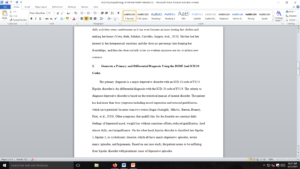Statistical manual of mental disorder
| Purpose: | Analyze and apply critical thinking skills in the psychopathology of mental health patients and provide treatment and health promotion while applying evidence-based research. |
| Scenario: | Kel is a 42-year-old certified public accountant (CPA) who dreams each year that she will board a cruise ship the day after Tax Day and go somewhere, anywhere, except Portsmouth, Virginia. Each year the dream, like the ocean, ebbs and flows, but this year she is not even going to think about such a “ridiculous idea.” In fact, she does not even have the energy to dream; getting out of bed and preparing to go to work is simply too labor intensive.
Each evening Kel retires to bed with a lack of energy to complete her normal tasks such as readying her clothes for work and making a lunch. She lacks the energy to shop in the evening; consequently, she eats mostly crackers and canned soup. She is not hungry, and her scale reflects this. She has lost 15 pounds over the last 2 months. She does not attend to her makeup or clothes; she finds both too taxing. The clothes she selects are drab and not ironed. At work she makes no effort to talk with her co-workers and does not initiate new contacts with clients. The normal work of filing taxes and writing reports, which she used to enjoy, are overwhelming, and she feels too disorganized to complete them. Telephone calls and e-mail messages from friends are ignored. Attendance at work is spotty. Sue, her sister, becomes alarmed with Kel’s unanswered telephone calls and e-mails. Worried, she decides to visit her sister at home. She finds the apartment unclean and in disarray. Kel is unkempt, disheveled, and looks sad. Her voice is monotone and flat. Kel tells Sue that she feels “sad and hopeless. Nothing is ever going to change. I am a bad person and I can’t even do my work right. Although I sleep for many hours, I am still tired all the time.” Sue is alarmed at the changes in her sister and arranges for Kel to visit a health care worker at the medical clinic. |
| Questions: | Remember to answer these questions from your textbooks and NP guidelines. At all times, explain your answers.
|
Requirements: 500 words
Answer preview
Compared to associated risk factors, suicide is rare, and it is hard to predict who is at risk. However, medical practitioners should be aware of the risk factors and warning signs to help screen, refer and document suicide risks. For a successful screening, patients should use different tools, including patient health questionnaire 2 (PHQ2), which involves a patient answering two questions involving little interest in activities, depression, or hopelessness. That can only be done with no additional questions or interventions (Drapeau, Nadorff, McCall, Titus, Barclay, et al., 2019). Another tool is the patient health questionnaire (PHQ9), used to detect depression and measure its severity and the best medication. The PHQ9 is administered to patients who responded positively to any questions in PHQ2.
[722 Words]

Statistical manual of mental disorder

